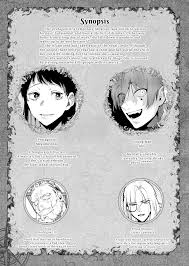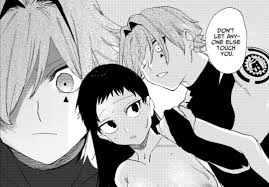Unmasking the Paradox: The Man Who Saved Me on My Isekai Trip Was a Killer



Chính Sách Vận Chuyển Và Đổi Trả Hàng
Miễn phí vận chuyển mọi đơn hàng từ 500K
- Phí ship mặc trong nước 50K
- Thời gian nhận hàng 2-3 ngày trong tuần
- Giao hàng hỏa tốc trong 24h
- Hoàn trả hàng trong 30 ngày nếu không hài lòng
Mô tả sản phẩm
The allure of the isekai genre is undeniable. It promises escapism, adventure, and the thrilling fantasy of being transported to a new world, often with unique powers or a grand destiny. Central to many of these narratives is the figure of the savior – the powerful, benevolent individual who rescues the bewildered protagonist from immediate danger and guides them through the perilous new reality. Yet, what if the very foundation of this heroic archetype crumbles under scrutiny? What if the man who saved me on my isekai trip was a killer? This fascinating, unsettling, and increasingly popular narrative twist forces audiences to confront profound questions about morality, trust, and the true nature of heroism. It transforms a simple tale of rescue into a complex psychological drama, pushing the boundaries of traditional fantasy and reflecting a modern audience's desire for deeper, more nuanced storytelling. This article delves into the captivating complexities and implications of this compelling trope, exploring its psychological depth, narrative power, and the ethical dilemmas it unearths.
The Isekai Trope Reimagined: Beyond Heroic Archetypes
Traditional isekai narratives often operate within clearly defined moral boundaries. Heroes are noble, villains are despicable, and the lines between good and evil are rarely blurred. The savior character, in particular, is typically portrayed as a paragon of virtue: courageous, self-sacrificing, and morally unimpeachable. They are the light guiding the protagonist through the darkness, a symbol of hope and unwavering protection. However, the trope where the man who saved me on my isekai trip was a killer fundamentally subverts this established convention. It introduces a jarring, yet compelling, dissonance that challenges the very premise of the genre.
This subversion resonates deeply with contemporary audiences who are often weary of simplistic narratives. There's a growing appetite for stories that reflect the complexities of the real world, where heroes are flawed, and morality is rarely black and white. By presenting a savior who is also a killer, the narrative shatters expectations, immediately establishing a sense of unease and unpredictability. It forces the reader or viewer to re-evaluate their preconceptions about heroism and villainy, creating a rich tapestry for exploring shades of gray. This unexpected twist elevates the story from a straightforward fantasy adventure to a psychological thriller, injecting a potent dose of realism and moral ambiguity into a genre often criticized for its predictability.
The initial shock value of this revelation is immense, but its lasting impact lies in the profound narrative tension it creates. The protagonist's gratitude is immediately tinged with fear, their safety becomes precarious, and their understanding of the world they've been thrust into is irrevocably altered. This isn't just a hero with a dark past; it's a protector with a lethal present, capable of both immense good and profound violence. This dynamic transforms the relationship between the savior and the saved, moving beyond simple admiration to a complex web of dependence, suspicion, and perhaps, even a strange form of understanding. It’s a testament to how evolving storytelling can breathe new life into beloved genres, demonstrating that the most compelling narratives often lie in the unexpected and the morally challenging.
The Psychological Labyrinth of the Savior-Killer
The true genius of a story where the man who saved me on my isekai trip was a killer lies in its profound psychological depth. Such a character is a walking paradox, a crucible of internal conflict that offers immense potential for exploration. This complexity extends not only to the enigmatic savior but also to the protagonist who must navigate this perilous relationship.
Internal Conflict and Moral Ambiguity
For the savior, the internal landscape is a tumultuous battlefield. How does one reconcile the act of saving a life with the act of taking one? What drives them? Is their killing a product of a brutal past, a necessary evil in a cruel world, or simply an innate part of their nature that they struggle to control? They might operate under a warped sense of justice, believing that some lives are expendable for the greater good, or perhaps they are haunted by their past deeds, seeking a twisted form of redemption through selective acts of protection. This moral ambiguity is precisely what makes them so compelling. They are not merely an anti-hero; they are a character who embodies the very contradiction of life and death, creation and destruction. Exploring their motivations – be they trauma, ideology, or a desperate fight for survival – allows for an incredibly rich character study. It forces the audience to ponder the nature of good and evil, and whether true morality lies in actions or intentions. Do their protective instincts stem from a genuine desire to do good, or are they a mechanism to cope with or justify their violent tendencies?
The Protagonist's Dilemma
Equally captivating is the psychological journey of the protagonist who is saved by such a figure. Their initial relief quickly gives way to terror, confusion, and a profound ethical quandary. How do you trust someone whose hands are stained with blood, even if that blood wasn't yours? Do you fear them, resent them, or try to understand them? This situation can lead to fascinating dynamics, including a form of Stockholm syndrome, a desperate attempt to rationalize the killer's actions, or a constant state of hyper-vigilance. The protagonist's own moral compass is severely tested. Do they accept the killer's methods as a necessary evil in this new, dangerous world? Do they try to reform their savior, or do they seek escape? Their growth often stems from confronting this immense moral challenge, forcing them to mature rapidly and develop a more nuanced understanding of right and wrong, survival, and compassion. The relationship becomes less about simple guardianship and more about a volatile partnership, where the protagonist is constantly weighing their own safety against their ethical convictions.
Narrative Potential and World-Building Implications
Beyond the individual psychological complexities, the premise that the man who saved me on my isekai trip was a killer unlocks an extraordinary amount of narrative potential and allows for richer, more immersive world-building within the isekai genre. This single character choice can ripple through every aspect of the story, elevating it far beyond typical fantasy tropes.
Unpredictability and Suspense
The most immediate narrative benefit is the inherent unpredictability. With a savior who is also a killer, no situation is entirely safe, and no character interaction is straightforward. The audience is kept on edge, constantly wondering: When will their "killer" nature resurface? Who will be their next victim? Is the protagonist truly safe, or are they just the killer's current fascination? This constant undercurrent of tension avoids the pitfalls of predictable plotlines, where the hero always acts heroically and threats are clearly defined. It introduces a deeply unsettling element of domestic terror within the protection, making even quiet moments fraught with potential danger. This sustained suspense keeps readers thoroughly engaged, eager to uncover the true nature of their complex savior and the dark secrets that might still unfold.
Darker Themes and Mature Storytelling
This trope naturally lends itself to exploring darker, more mature themes. It delves into the nature of evil, the blurred lines of justice, the weight of trauma, and the arduous path to redemption—if redemption is even possible for such a character. The world itself can be depicted as grittier and more morally ambiguous, reflecting the savior's own conflicted nature. This allows for complex political landscapes, ethical systems that are not simply good or evil, and a deeper dive into the consequences of violence. Stories that embrace this theme often move beyond simple adventure to become profound commentaries on human nature, survival, and the compromises people make when pushed to their limits. It allows authors to tackle topics like war crimes, vigilantism, and the very definition of humanity in a fantastical setting, appealing to an audience seeking more thought-provoking content.
Character Development Opportunities
The dynamic between the killer-savior and the saved protagonist offers unparalleled opportunities for character development for both parties. The savior, despite their violent tendencies, might slowly begin to find a shred of humanity or purpose through their connection with the protagonist, leading to subtle changes in their behavior or moral code. This isn't about an instant redemption arc, but a slow, arduous process of questioning their own existence. For the protagonist, this relationship forces them to confront their own biases, fears, and moral boundaries. They might learn to see beyond the acts of violence to understand the underlying motivations, or they might struggle to maintain their innocence in a world that demands a different kind of strength. Their journey becomes one of profound psychological growth, learning to navigate trust in the face of terror, and perhaps even finding a strange form of empathy for someone who defies conventional understanding. The evolution of their bond, from fear and dependence to a more complex, perhaps even co-dependent, relationship, is incredibly fertile ground for compelling storytelling.
Real-World Parallels and Ethical Questions
The narrative device where the man who saved me on my isekai trip was a killer resonates beyond the confines of fantasy, touching upon profound real-world parallels and ethical dilemmas that have long puzzled philosophers and societies. This trope, while fantastical, serves as a powerful metaphor for examining complex moral quandaries in our own world.
Consider the figures in real life who perform morally ambiguous actions for what they believe to be a greater good: soldiers in war who must kill to protect, intelligence operatives engaging in covert operations with lethal consequences, or even vigilantes who take justice into their own hands. These individuals often operate in a grey zone, where their actions are simultaneously abhorrent and, arguably, necessary. The killer-savior in an isekai world embodies this conundrum, forcing the audience to ponder the utilitarian argument: do the ends justify the means? If a killer saves innocent lives, does their past or present violence negate the good they do? This challenges our inherent desire for heroes to be pure and untainted, pushing us to accept that protection can come from unexpected, and even disturbing, sources.
Furthermore, this trope prompts a deep dive into ethical philosophy. It brings into sharp focus the tension between deontological ethics (where actions are judged by adherence to rules, regardless of outcome) and consequentialist ethics (where actions are judged by their outcomes). A deontologist might argue that killing is inherently wrong, regardless of who is saved. A consequentialist might argue that saving many lives, even through violent means, is the ultimate good. The character of the killer-savior personifies this very debate, inviting the audience to engage with these complex ideas rather than passively consume a straightforward narrative. It forces a critical examination of terms like 'justice,' 'redemption,' and 'forgiveness,' asking if someone who commits heinous acts can ever truly atone, or if their 'good' deeds merely serve to highlight their capacity for 'evil.' By blurring the lines of morality, these stories not only entertain but also provoke thought, making them powerful tools for social and ethical commentary disguised within a fantastical setting.
Why "The Man Who Saved Me on My Isekai Trip Was a Killer" Resonates
The enduring popularity and critical success of stories where the man who saved me on my isekai trip was a killer is not accidental. It speaks to a profound shift in audience preferences and a growing maturity within the fantasy genre itself. This trope resonates for several key reasons, each contributing to its unique appeal and lasting impact.
Firstly, there's a widespread rejection of simplistic narratives. Modern audiences are increasingly sophisticated and weary of predictable plotlines where heroes are infallible and villains are cardboard cutouts. The killer-savior trope offers a refreshing departure from this, providing a protagonist who is forced to grapple with moral ambiguity and a world that mirrors the complexities of reality. It reflects a desire for stories that acknowledge the shades of grey that exist in human nature and in the world at large.
Secondly, the appeal lies in the embrace of flawed characters. There's an inherent fascination with individuals who are deeply scarred, morally compromised, yet capable of profound acts of courage or kindness. These characters feel more human, more relatable in their imperfections, even as their actions might be horrific. Their internal struggles and potential for both good and evil make them endlessly intriguing, sparking empathy and curiosity in equal measure. The audience becomes invested not just in what they do, but in who they are and who they might become.
Thirdly, this subversion pushes the boundaries of the isekai genre, allowing for explorations of darker, more profound themes. It ventures into the psychological depths of trauma, survival, and the true cost of power. Such narratives invite critical thinking, prompting discussions about ethics, redemption, and the nature of good and evil. They are not merely escapist fantasies but thought-provoking commentaries on the human condition, making them more intellectually stimulating and emotionally resonant.
Finally, the sheer thrill of psychological depth and unpredictability keeps audiences captivated. The constant question of the savior's true motives and the potential for their 'killer' nature to resurface adds an unparalleled layer of suspense. This dynamic ensures that the narrative remains fresh and exciting, moving beyond conventional hero journeys to explore the terrifying yet compelling dance between protector and predator. Ultimately, the resonance of this trope signifies a maturation of the fantasy genre, catering to an audience that desires complexity, moral challenges, and characters that defy easy categorization.
Conclusion
The powerful narrative device where the man who saved me on my isekai trip was a killer has irrevocably transformed the landscape of the isekai genre. Far from being a mere gimmick, it represents a sophisticated evolution in storytelling, addressing the contemporary audience's appetite for complexity, moral ambiguity, and profound psychological exploration. We have seen how this trope shatters traditional heroic archetypes, forcing a re-evaluation of what it means to be a savior and a protector in a perilous new world.
The internal conflicts of the killer-savior and the harrowing dilemmas faced by the protagonist create a rich tapestry of character development, pushing both individuals to their limits and revealing the nuanced spectrum of human nature. This narrative choice injects unparalleled unpredictability and suspense, allowing for the exploration of darker, more mature themes that delve into the heart of justice, redemption, and survival. Moreover, it serves as a potent mirror to real-world ethical questions, inviting audiences to critically engage with ideas of necessary evil and the blurred lines between good and bad.
Ultimately, the resonance of this compelling trope lies in its rejection of simplistic narratives and its embrace of deeply flawed yet captivating characters. It signifies a maturation within fantasy, moving beyond clear-cut battles to explore the tumultuous inner landscapes of its inhabitants. As the genre continues to evolve, stories featuring a savior whose hands are stained with blood will undoubtedly remain at the forefront, challenging perceptions and proving that the most compelling heroes are often the ones shrouded in the darkest shadows.